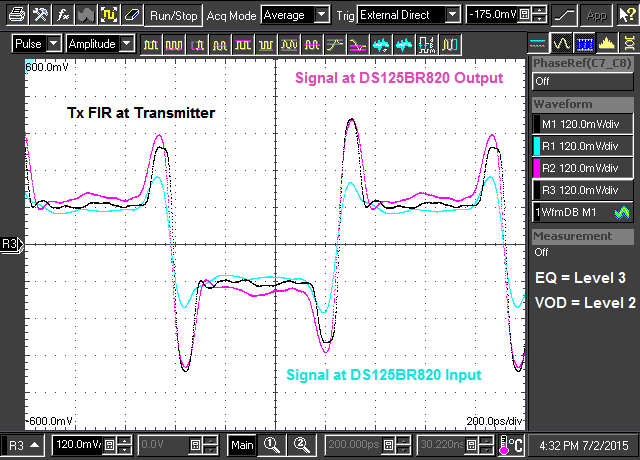SNLA236 September 2015 DS125BR111 , DS125BR401A , DS125BR820
2.2 Using Linear Equalization to Recover Tx FIR Information
Tx equalization or Tx Finite Impulse Response (FIR) is used in SAS-3 to assist the SAS-3 receiver in establishing a robust communication link across the system interface. When the system is physically large and the serial data-rate is increased, there is going to be an increase in the overall attenuation or loss present in the transmit channel. Since the SAS-3 specification utilizes a Rx – Tx training algorithm to optimize the overall equalization solution, it is important that any intermediate component provide a linear response. Keeping the whole system relatively linear enables the SAS-3 transmit signals to reach through the linear equalizer and make an impact on the SAS-3 receiver eye opening. Without this linear behavior the training process is likely to result in sub-optimal solutions.
In order to demonstrate the linear nature of the DS125BR820, a transmit waveform with TX FIR energy was observed. Placing the DS125BR820 within the active channel at a point 8 dB removed from the SAS-3 transmitter output shows how linear equalization can recover high frequency energy lost due to attenuation and retain critical low frequency information as well. This preserves the transmitted waveform analog characteristics.
 Figure 3. Transmitted and Recovered SAS-3 Waveforms
Figure 3. Transmitted and Recovered SAS-3 Waveforms The SAS-3 Tx and equalizer input/output waveforms in Figure 3 are aligned in time. Much of the original Tx information has been lost due to attenuation (Light Blue Waveform). Linear equalization on the DS125BR820 output (Magenta Waveform) is still able to recover and reproduce the analog characteristics of the original FIR Tx waveform (Black Waveform).